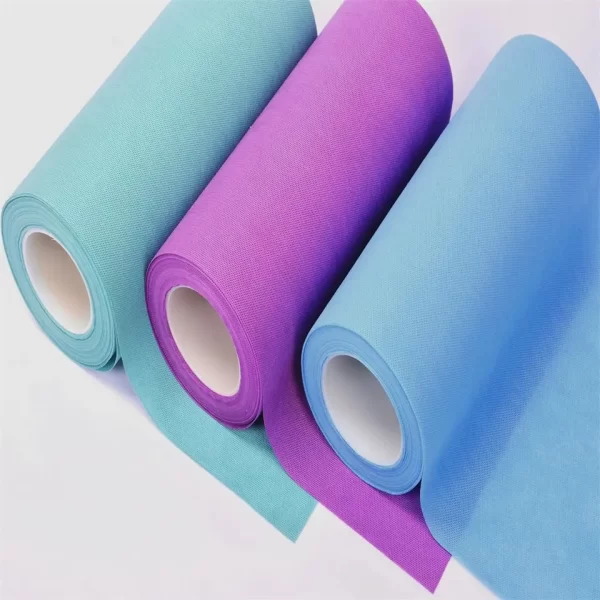SMS Nonwoven Fabrics VS Traditional Woven Fabrics
A Deeper Look into the Fabrication Process
Traditional woven fabrics are created using two distinct sets of yarns, the warp (lengthwise arrangement) and the weft (crosswise arrangement). These yarns are interlaced with each other typically at right angles, creating a crisscross pattern. The characteristics of woven fabrics largely depend on the fiber type, yarn quality, and the particular weave pattern (such as plain, twill, or satin). However, the fundamental principle of interlacing threads remains the same.
On the contrary, the production of SMS nonwoven fabrics is a marvel of modern textile engineering. The process begins with the selection of the polymer, most commonly polypropylene. The first step involves the conversion of polypropylene granules into filaments through a high-speed extrusion process known as spunbonding. Then comes the meltblowing stage where the polymer is melted and extruded through fine nozzles, with high-velocity hot air streams blowing the extruded polymer onto a conveyor. These ultra-fine fibers form a web, which is self-bonded to create a fabric with excellent barrier properties. Lastly, another layer of spunbonding gives the fabric its strength and stability. The final product is a nonwoven fabric that combines the strength of spunbond layers with the barrier properties of a meltblown layer.
Going Beyond the Surface: Unveiling the True Advantages
Broad-spectrum Customization: Achieving the Ideal Fabric
While woven fabrics offer a degree of customization through the choice of fiber, yarn, color, and pattern, the scope of customization in SMS nonwoven fabrics is truly remarkable. By varying the polymer type, processing conditions, and additives, manufacturers can create SMS fabrics with a wide array of characteristics. For instance, the fabric can be engineered to be softer for use in hygiene products, or more absorbent for spill control applications, or more durable for industrial usage.
Streamlined Manufacturing and Lower Costs
SMS nonwoven fabrics score high on economic feasibility. The direct transformation from raw material to finished product without the need for yarn spinning or weaving makes the manufacturing process of SMS nonwoven fabrics highly efficient. High-speed production lines further enhance productivity, reducing costs. Furthermore, the ability to create a finished product in a single manufacturing process – incorporating both fabric formation and finishing – also contributes to cost savings.
On the other hand, the manufacturing of woven fabrics involves separate processes for yarn spinning, weaving, dyeing, and finishing, leading to higher costs. The need for skilled labor for different operations also adds to the cost.
A Protective Shield: Excellent Barrier Properties
One of the standout advantages of SMS nonwoven fabrics is their superb barrier properties, attributable to the meltblown layer. The tiny fibers and dense structure of this layer create an effective barrier against the ingress of particles, bacteria, and liquids. These properties are critical in applications where protection against contamination is paramount.
On the other hand, while woven fabrics can be treated or coated to enhance their barrier properties, these are typically not inherent to the fabric. The degree of protection depends on the tightness of the weave, the weight of the fabric, and the type of finishing treatment applied.
Keeping Comfort at the Forefront: Breathability and Comfort
Despite their protective properties, SMS nonwoven fabrics do not compromise on comfort. The fabric’s structure allows air to pass through while blocking the passage of fluids and particles, providing breathability. This balance of protection and comfort is essential in applications where the fabric is worn close to the skin, such as in protective apparel and hygiene products.
In comparison, while woven fabrics can also offer breathability and comfort, achieving the desired level of both comfort and protection can be challenging. A tighter weave for better protection could compromise breathability and vice versa.
Unveiling the Wide Array of Applications: From Healthcare to Agriculture
The versatility, cost-effectiveness, and superior performance of SMS nonwoven fabrics translate into an expansive range of applications.
Reinventing Healthcare
SMS nonwoven fabrics have dramatically changed the landscape of healthcare textiles. The need for sterility in medical settings cannot be overstated. In this context, the superior barrier properties of SMS nonwoven fabrics play a vital role. They are used extensively in the production of surgical drapes, gowns, caps, and masks, offering both the healthcare professional and the patient a high level of protection.
Moreover, the comfort factor is also important for patient gowns and bedding. The softness and breathability of SMS fabrics enhance patient comfort, which can be a significant factor in patient satisfaction and recovery.
Redefining Personal Protection
The global pandemic has underlined the importance of reliable and effective personal protective equipment (PPE). SMS nonwoven fabrics, with their excellent filtration efficiency and comfort, are a preferred choice for protective apparel, including coveralls, aprons, and headcovers. Their ability to act as a barrier against aerosols and liquids while allowing air circulation makes them an ideal material for PPE.
Elevating Hygiene Standards
Hygiene products such as baby diapers, adult incontinence products, and feminine hygiene products benefit from the use of SMS nonwoven fabrics. The fabrics’ superior liquid absorption, softness, and comfort contribute to product performance and user comfort. Additionally, the barrier properties of SMS fabrics help in containing fluids, thereby improving the efficacy of these products.
Safeguarding Agriculture
SMS nonwoven fabrics are increasingly used as crop covers in agriculture, offering protection against pests, harsh weather, and diseases. Their light weight makes them easy to install and remove, and their permeability allows water and light to reach the plants. At the same time, they provide a physical barrier against pests and frost, enhancing crop yields.
The comparison between traditional woven fabrics and SMS nonwoven fabrics clearly highlights the significant advantages of the latter in terms of customization, efficiency, performance, and cost-effectiveness. As industries continue to evolve and seek innovative solutions, the usage of SMS nonwoven fabrics is poised to expand further. Embracing these advanced textiles can lead to improved product performance, enhanced user comfort, and better overall value.
Please visit our website for more product details https://medposnonwoven.com/product/sms-non-woven-fabric/

